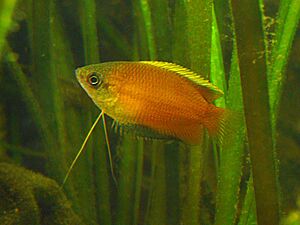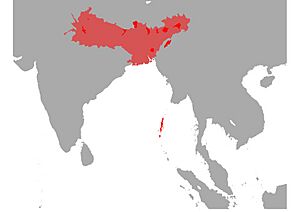Honey gourami facts for kids
Quick facts for kids Honey gourami |
|
|---|---|
 |
|
| Conservation status | |
| Scientific classification | |
 |
|
| Red: extant , Light red: possibly extant | |
| Synonyms | |
|
The honey gourami (Trichogaster chuna) is a type of fish called a gourami. It comes from rivers and lakes in India and Bangladesh.
Contents
Where Honey Gouramis Live
Honey gouramis are found in rivers and lakes in their home countries, India and Bangladesh. They like areas with lots of plants in soft water. These fish usually swim near the top or middle of the water.
What Honey Gouramis Look Like
Honey gouramis have orange bodies. They can grow to about 5.5 centimeters (2.2 inches) long. Male honey gouramis are usually more colorful than females. This is common for many types of gouramis.
Male and Female Differences
Male honey gouramis have bright orange around their throats. When it's time to breed, this color gets even brighter. They use this bright color to attract females. The male's underside also turns black during breeding.
Males have a bit of an orange color in their fins, except for their tail fin. Their fins are also longer, with a pointed top fin and longer bottom fin rays.
Different Color Types
People have bred honey gouramis to create two other color types. One is a red-orange type called "sunset" or "robin red." The other is a lighter type called "gold." Sometimes, the red-orange type can look like the red dwarf gourami.
Keeping Honey Gouramis in Aquariums
Honey gouramis are usually peaceful fish. They are good for small aquariums, especially tanks that are 10 gallons or larger. However, male honey gouramis can sometimes fight with each other. It's best to keep them apart unless the tank is very big. A large tank allows them to have their own space.
Setting Up Their Tank
A tank for honey gouramis should have lots of plants and decorations. This gives them places to hide. Honey gouramis can be a bit shy, like the dwarf gourami. So, it's best to avoid very aggressive tank mates.
Good tank mates include peaceful fish like tetras, barbs that don't nip fins, corydoras, and platys. It's usually not a good idea for new fish keepers to mix honey gouramis with other types of gouramis.
Water Conditions
The water temperature should be between 22 and 28 degrees Celsius (71-82 degrees Fahrenheit). The water chemistry is not super strict, but you should avoid extreme conditions.
Red Honey Gourami
There is a special color type called the red honey gourami. It is a bit redder than the regular honey gourami. When a male red honey gourami is ready to breed, its color becomes an even darker red or orange.
Honey Gourami Reproduction
Honey gouramis build "bubble nests" to lay their eggs. They use plants to help hold the bubbles together.
Spawning Process
When it's time for them to lay eggs, the water level in the tank should be lowered to about 8 inches. The temperature should be around 28 degrees Celsius (82 degrees Fahrenheit), and the water's pH should be around 7. It's a good idea to move your gouramis to a separate tank for breeding. Make sure the tank is covered.
When the male is ready, he will build a small bubble nest in one part of the tank. He will show off his bright colors to get the female's attention.
When the female comes close, the spawning process begins. The male wraps himself around the female. As they roll over, the eggs are released and fertilized at the same time.
Caring for Eggs and Fry
The eggs slowly sink to the bottom of the tank. The male then gathers them and puts them into the bubble nest. Unlike many other fish, the male honey gourami takes care of the eggs. He guards the nest and fixes it if needed. The female usually leaves the area.
The eggs hatch after two days. The baby fish, called fry, start swimming freely three days later. When they begin to swim, they should be fed tiny organisms called infusoria. About 10 days later, they can eat brine shrimp. After three weeks, they can eat finely ground fish flakes. Older fry can also eat freeze-dried tablets.


